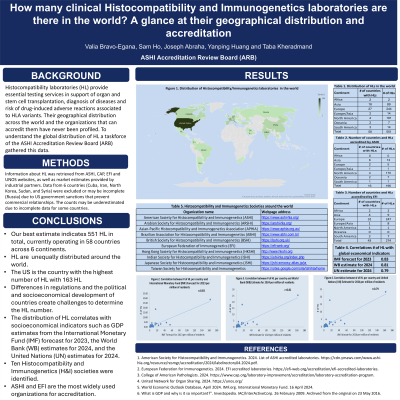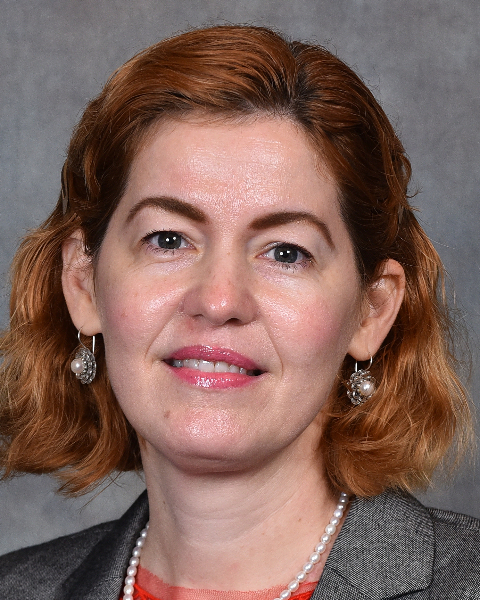Back

(P602) How many clinical Histocompatibility and Immunogenetics laboratories are there in the world? A glance at their geographical distribution and accreditation.
Location: Platinum Ballroom

Poster Presenter(s)
Aim: Histocompatibility laboratories (HL) provide essential testing services in support of organ and stem cell transplantation, diagnosis of diseases and risk of drug-induced adverse reactions associated to HLA variants. Their geographical distribution across the world and the organizations that can accredit them have never been profiled. To understand the global distribution of HL a taskforce of the ASHI Accreditation Review Board (ARB) gathered this data.
Method: Information about HL was retrieved from ASHI, CAP, EFI and UNOS websites, as well as market estimates provided by industrial partners. Data from 6 countries (Cuba, Iran, North Korea, Sudan, and Syria) were excluded or may be incomplete (Russia) due to US government sanctions that prevent commercial relationships. The counts may be underestimated due to incomplete data for some countries.
Results: Our best estimate indicates 551 HL in total, currently operating in 58 countries across 6 continents. These labs are unequally distributed (figure 1). The US is the country with the highest number of HL (163). Differences in regulations and the political and socioeconomical development of countries create challenges to determine the HL number. The distribution of HL correlates with socioeconomical indicators such as GDP estimates from the International Monetary Fund, the World Bank, and the United Nations with correlation indexes of 0.83, 0.81 and 0.79 respectively. Similar variability was found for accreditation. Ten Histocompatibility and Immunogenetics (H&I) societies were identified. Some provide accreditation recognized by local governments (Table 1). ASHI and EFI are the most widely used organizations, with196 and 274 accredited HL, respectively. The two more prevalent models of operations are: the transplant program is associated to a lab from the same institution or to a centralized lab that provides services for multiple programs in a region. Some countries use commercial labs to perform some of the testing.
Conclusion: This data highlights the disparity in patients’ access to clinical H&I testing around the world. This information will help ASHI and ARB implementing strategies for promoting collaboration, sharing of knowledge and best practices among sister societies, particularly with those serving in regions with limited resources, with the goal of improving patient care.
Method: Information about HL was retrieved from ASHI, CAP, EFI and UNOS websites, as well as market estimates provided by industrial partners. Data from 6 countries (Cuba, Iran, North Korea, Sudan, and Syria) were excluded or may be incomplete (Russia) due to US government sanctions that prevent commercial relationships. The counts may be underestimated due to incomplete data for some countries.
Results: Our best estimate indicates 551 HL in total, currently operating in 58 countries across 6 continents. These labs are unequally distributed (figure 1). The US is the country with the highest number of HL (163). Differences in regulations and the political and socioeconomical development of countries create challenges to determine the HL number. The distribution of HL correlates with socioeconomical indicators such as GDP estimates from the International Monetary Fund, the World Bank, and the United Nations with correlation indexes of 0.83, 0.81 and 0.79 respectively. Similar variability was found for accreditation. Ten Histocompatibility and Immunogenetics (H&I) societies were identified. Some provide accreditation recognized by local governments (Table 1). ASHI and EFI are the most widely used organizations, with196 and 274 accredited HL, respectively. The two more prevalent models of operations are: the transplant program is associated to a lab from the same institution or to a centralized lab that provides services for multiple programs in a region. Some countries use commercial labs to perform some of the testing.
Conclusion: This data highlights the disparity in patients’ access to clinical H&I testing around the world. This information will help ASHI and ARB implementing strategies for promoting collaboration, sharing of knowledge and best practices among sister societies, particularly with those serving in regions with limited resources, with the goal of improving patient care.

